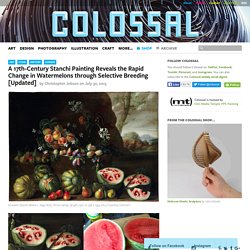

Caravaggio "The Crucifixion of Saint Peter" (1601) Caravaggio "The Sacrifice of Isaac" (1605) Caravaggio "St. Jerome" (1605/6) Adam Elsheimer "The Flight to Egypt" (1608) Matthias Stom "The Annunciation" (1600's) Reza Abbasi "Two Lovers" (1630) Rembrandt "The Storm on the Sea of Galilee" (1633) Matthias Stom "The Adoration of the Magi" (1630's) Giovanni Battista Salvi da Sassoferrato "Virgin Mary" (mid-1600's) Claude Lorrain "The Embarkation of the Queen of Sheba" (1648) Gerard Houckgeest "Ambulatory of the Nieuwe Kerk in Delft, with the tomb of Willem I" (1651) Rembrandt "An Old Man in Red" (1653) Jan van Kessel Jr. "Alimentation et gastronomie" (1654) Diego Velazquez "Las Meninas" (1656)
Revenge Fantasies of Artemisia Gentileschi. In 1991, pioneering feminist art historian Mary Garrard published a controversial monograph on the life and works of Baroque artist Artemisia Gentileschi.

Much of Gentileschi’s chosen subject matter centers around female characters, which Garrard says demonstrates a desire to portray self-possessed women. But Garrard’s analysis is not simply concerned with empowerment or success in a male-dominated field. She contests that Gentileschi’s earliest paintings are a direct response to living in an intensely patriarchal culture as a rape victim. Furthermore (and this is where the controversy comes in), the author posits that these paintings act as Gentileschi’s latent revenge fantasies. Artemisia Gentileschi was born in Rome in 1593 to Tuscan painter Orazio Gentileschi, who was heavily inspired by the work of Caravaggio. This subject is an unusual one for Gentileschi to choose for several reasons. Gentileschi’s painting does not utilize common tropes.
Oh, yes. Jan van Kessel Sr. "The Mockery of the Owl" (17th Century) Jan Van Kessel Sr. "Festoons of Seashells" (1656) Ogata Kōrin "Red and White Plum Blossoms" (1712) Rosalba Carriera "Young Girl Holding a Monkey" (1721) Byeon Sang-byeok "Myojakdo (Painting of Cats and Sparrows)" (1730) Rosalba Carriera "A Venetian Lady from the House of Barbarigo" (1735) George Stubbs "Mares and Foals..." (1766) Ogata Kōrin "Waves at Matsushima" (18th century) Joseph Wright of Derby "The Orrery" (1766) A 17th-Century Stanchi Painting Reveals the Rapid Change in Watermelons through Selective Breeding. Giovanni Stanchi (Rome c. 1645-1672).

Oil on canvas. 38 5/8 x 52½ in. (98 x 133.5 cm.) / Courtesy Christie’s Old master work paintings are frequently cited for their depiction of historical events, documentation of culture, or portraiture of significant people, but there’s one lesser known use of some paintings for those with a keen eye: biology. One such instance is this Renaissance still life of various fruits on a table by Giovanni Stanchi painted sometime in the 1600s that shows a nearly unrecognizable watermelon before it was selectively bred for meatier red flesh.
Horticulture professor James Nienhuis at the University of Wisconsin tells Vox that he’s fascinated by old still life paintings that often contain the only documentation of various fruits and vegetables before we transformed them forever into something more desirable for human use. You can read a bit more about the science behind the changes in watermelons over the last 350 years here. Joseph Wright of Derby "An Experiment on a Bird in an Air Pump" (1768) Charles W. Peale "Portrait of George Washington" (1772) George Stubbs "Cheetah with two Indian servants and a deer" (1764) Jacques-Louis David "Diana and Apollo Piercing Niobe’s Children with their Arrows" (1772)
Jacques-Louis David "Antiochus and Stratonica" (1774) John Singleton Copely "Watson and the Shark" (1778) Jacques-Louis David "Patroclus" (1780) Jean-Honoré Fragonard "The Lock" (1780) Henry Fuseli "The Nightmare" (1781) George Stubbs "Portrait of a white dog..." (1781) Jacques-Louis David "Equestrian portrait of Stanisław Kostka Potocki" (1781) Jacques-Louis David "Oath of the Horatii" (1786) Jacques-Louis David "The Death of Socrates" (1786) Henry Fuseli "Titania and Bottom" (1790) Anne-Louis Girodet "The Sleep of Endymion" (1791) Painted Thangka of the Jatakas (~18th-19th Century AD) Jacques-Louis David "The Death of Marat" (1793) Hari-shigoto ("Needlework"), (1794–95) Utamaro "Takashima Ohisa using two mirrors..." (1795)
Anne-Louis Girodet "Portrait of Jean-Baptiste Belley" (1798) Jacques-Louis David "unfinished portrait of Napoleon" (1798) Jacques-Louis David "The Intervention of the Sabine Women" (1799)